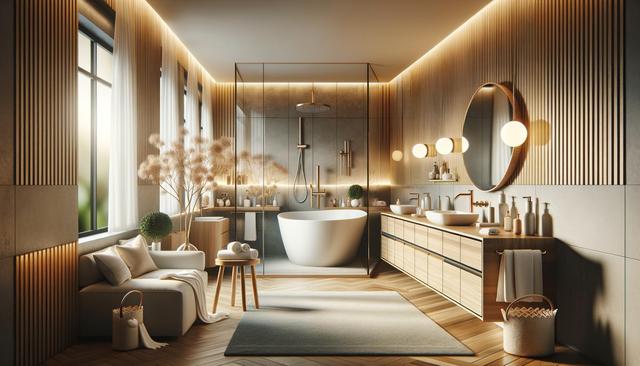Planning Your Bathroom Remodel
Before diving into any renovation, it’s essential to start with a clear plan. A successful bathroom remodel begins with assessing your current space and identifying your goals. Are you looking to improve functionality, add luxury features, or simply refresh outdated elements? Defining your objectives will help guide your decisions on layout, materials, and budget. Creating a realistic timeline and setting financial boundaries can also ensure your project stays on track. Consider consulting a professional who specializes in home renovation to help develop a blueprint that aligns with your vision and needs.
During the planning phase, make a list of must-haves vs. nice-to-haves. This helps in prioritizing features, especially when working within a budget. Common must-haves might include:
- Improved lighting for better visibility
- Efficient storage solutions
- Updated plumbing fixtures
- Waterproof flooring
Once your priorities are set, you can explore remodeling ideas that suit both your aesthetic preferences and practical requirements.
Exploring Modern Bathroom Design Trends
Modern bathroom design is all about clean lines, minimalism, and smart functionality. One of the most popular trends today is the use of neutral color palettes, such as soft grays, whites, and earthy tones, which help create a calm and welcoming environment. Large-format tiles, floating vanities, and frameless glass showers are also gaining popularity for their streamlined look and ease of maintenance. These elements can dramatically change the feel of your bathroom, making it appear more spacious and luxurious.
Other emerging trends in bathroom upgrades include:
- Matte black or brushed gold fixtures for a sophisticated touch
- Backlit mirrors that add both function and ambiance
- Freestanding tubs for a spa-inspired experience
- Heated floors for added comfort during colder months
Incorporating these features into your bathroom remodel can greatly enhance both the aesthetics and usability of the space.
Functional Features That Elevate Daily Use
While aesthetics play a significant role in bathroom design, functionality should never be overlooked. Thoughtful design details can make everyday routines smoother and more enjoyable. For instance, installing recessed shelving in the shower keeps toiletries organized without cluttering the space. A double vanity can be a game-changer for shared bathrooms, providing ample space for two users simultaneously.
Storage is another crucial aspect. Built-in cabinets, under-sink drawers, and wall-mounted shelves help keep the bathroom tidy and efficient. Consider the following functional upgrades during your home renovation:
- Touchless faucets and toilets for hygiene and convenience
- Quiet-close toilet lids and cabinet drawers
- Ventilation fans with humidity sensors to prevent mold buildup
- Shower niches for easy access to bath products
These enhancements not only improve your experience but also add long-term value to your property.
Creating a Spa-Like Escape at Home
If relaxation is your goal, your bathroom remodel can transform the space into a tranquil retreat. Many homeowners are now incorporating elements typically found in spas to evoke a sense of calm and luxury. Soft lighting, natural materials like wood and stone, and soothing color palettes set a peaceful tone. Aromatherapy diffusers, rainfall showerheads, and deep soaking tubs contribute to a more immersive experience.
To create a spa-inspired bathroom, consider integrating the following features:
- Dimmable lighting to set the mood
- Sound systems for relaxing music
- Greenery or plant walls to add a natural touch
- Soft textiles such as plush towels and bath mats
By thoughtfully combining these elements, you can achieve a relaxing atmosphere that promotes wellness and comfort every day.
Budgeting and Choosing the Right Materials
Budgeting wisely is a critical part of any bathroom remodel. Costs can vary widely depending on the scope of the project, the quality of materials, and labor fees. Start by setting a realistic budget that includes a buffer for unexpected expenses. Researching and comparing options can help you make informed choices without sacrificing quality. From tiles and countertops to fixtures and cabinetry, selecting durable, water-resistant materials will ensure longevity and reduce maintenance needs.
When choosing materials, balance style with practicality. For example, porcelain tiles are not only stylish but also highly durable and moisture-resistant, making them ideal for bathrooms. Quartz or solid-surface countertops offer similar benefits while adding a sleek finish to your vanity area. Consider eco-friendly options, too, such as low-flow toilets and LED lighting, which help reduce water and energy consumption.
Working with experienced contractors or designers can also help you stay within budget while achieving your goals. Their guidance can streamline the remodeling process and help you avoid costly mistakes.
Conclusion: Designing a Bathroom That Works for You
A bathroom remodel offers a unique opportunity to enhance both the form and function of one of the most-used rooms in your home. Whether your focus is on achieving a spa-like retreat or improving everyday usability, thoughtful planning and design can make a significant difference. By incorporating current trends, functional features, and durable materials, your bathroom can become a space that reflects your personal style and supports your lifestyle. With careful budgeting and the right remodeling ideas, your updated bathroom will not only look great but also serve you well for years to come.




Leave a Reply